In Los Angeles, common slip and fall cases often arise from several hazardous situations. In grocery stores, wet floors and cluttered aisles pose significant risks, while uneven sidewalks and cracks are major concerns on city streets. Poor lighting in parking lots or walkways contributes to accidents, impacting workplace safety as well. Residential areas with poorly maintained driveways or blocked paths are frequent sources of falls. Weather-related issues, like rain making surfaces slick, add to the dangers. Construction sites, with debris and uneven ground, are also notable contributors. Understanding the legal responsibilities surrounding these hazards can help navigate them successfully.
Grocery Store Hazards
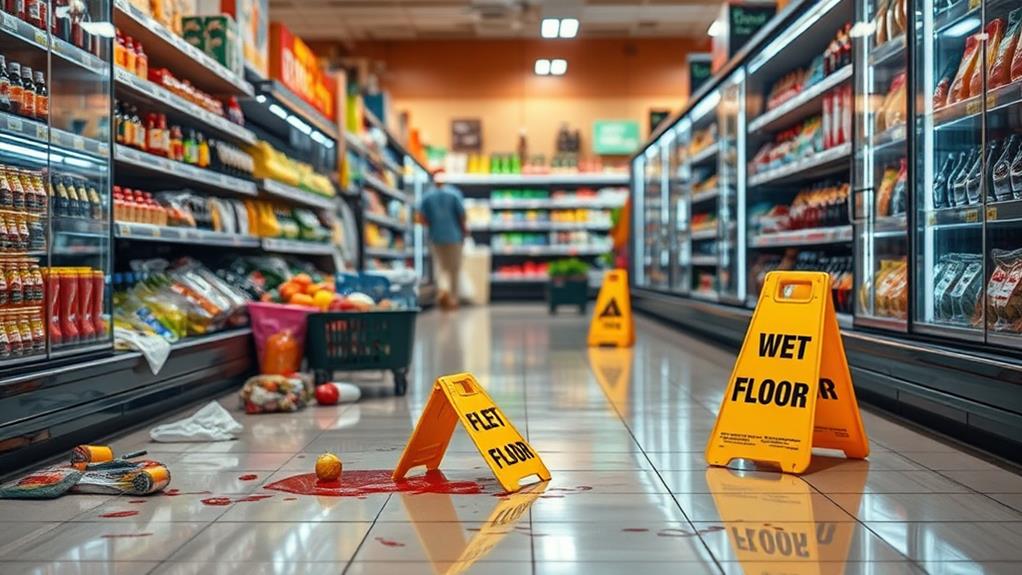
Maneuvering grocery stores can sometimes be risky due to common hazards like wet and slippery surfaces from spills. These slip and fall incidents are prevalent, particularly when food or liquid spills aren’t promptly addressed.
With high foot traffic, the chances of encountering slip and fall injuries increase, especially in crowded aisles. Often, improperly placed items, such as loose rugs or promotional displays, add to the grocery store hazards, creating tripping risks for you as you navigate the aisles.
Poor lighting can further obscure these dangers, making it difficult to spot potential threats. Grocery stores hold a legal responsibility, known as premises liability, to maintain safe environments and swiftly handle hazards.
If they fail, it might be seen as property owners’ negligence, which can lead to serious accidents. An injury attorney can help if you find yourself affected by such negligence, guiding you through any legal processes.
The common causes of these incidents highlight the need for vigilance, both from the store’s management and shoppers. By being aware of your surroundings and understanding the store’s obligations, you can better protect yourself from potential injuries while shopping.
Sidewalk and Pavement Issues
Maneuvering the sidewalks and pavements of Los Angeles presents unique challenges due to widespread issues like uneven surfaces. Uneven pavements, often caused by tree root growth and aging infrastructure, greatly increase the risk of slip and fall accidents. Over 60% of these claims involve tripping over such surfaces, highlighting the hazardous conditions pedestrians face daily.
Sidewalk cracks and potholes are common culprits, leading to serious injuries like fractures or head trauma.
As a pedestrian, you might assume that the city or a property owner or manager is responsible for keeping walkways safe. Indeed, the City of Los Angeles is tasked with maintaining sidewalks, but a backlog of repair requests can delay necessary fixes, leaving hazardous conditions unaddressed.
Property owners may also be accountable, especially if the hazard is on private land. Keeping detailed maintenance records can be essential when determining liability in these cases.
If you suffer injuries from a slip and fall due to sidewalk issues, you may consider filing a personal injury claim. This process can help you recover damages for your injuries and prompt necessary repairs to prevent future accidents.
Understanding your rights and responsibilities is important in maneuvering these situations.
Inadequate Lighting Dangers
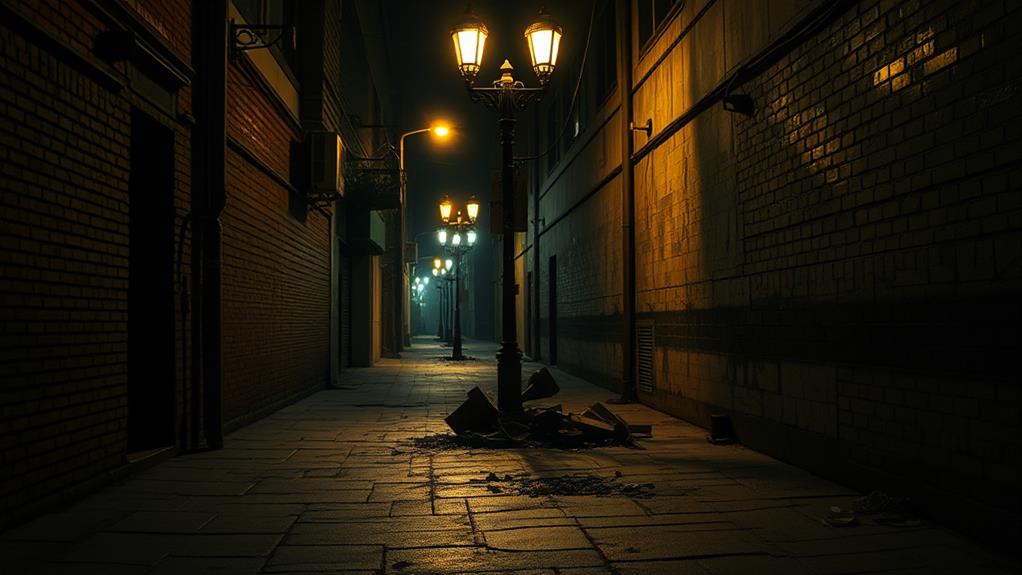
While inadequate lighting may seem like a minor concern, it considerably increases the risk of slip and fall accidents by compromising visibility and preventing you from spotting hazards like uneven surfaces or obstacles.
Poorly lit areas, especially in parking lots, stairwells, and walkways, account for many accidents, underscoring the need for proper illumination. Studies show that well-lit environments can reduce such incidents by up to 50%, which emphasizes the importance of sufficient lighting in both public and private spaces.
Property owners have a legal obligation to guarantee their premises are properly lit to prevent accidents. When they fail to do so, it can lead to negligence claims in slip and fall cases.
Fall attorneys often handle these claims, aiming to prove that the lack of adequate lighting directly contributed to the accident. According to the CDC, falls are a leading cause of injury-related deaths among older adults, and inadequate lighting is frequently a contributing factor.
If you ever find yourself in a dimly lit area, stay vigilant and proceed with caution.
Workplace Slip and Falls
Inadequate lighting isn’t just a concern in public spaces; it also plays a vital role in workplace safety. Workplace slip and falls are a leading cause of injuries in the U.S., with California seeing many incidents across its diverse employment sectors. Wet floors from spills or cleaning, uneven surfaces, and cluttered walkways frequently lead to slip and fall injuries. Such hazards contribute to over 20,000 fatalities annually.
An unsafe work environment not only affects employee morale but also raises liability issues for employers. Employers are legally obligated to maintain a safe work environment, regularly inspecting and addressing potential hazards. When negligence occurs, a personal injury attorney can assist you in maneuvering the legal landscape to recover damages.
In California, if you’re injured in a workplace slip and fall, you may be entitled to workers’ compensation. This compensation can cover medical expenses and lost wages, providing some relief as you recuperate.
To minimize risks, effective training and safety protocols are essential. Implementing non-slip mats and ensuring proper lighting can greatly reduce accidents. By addressing these issues, workplaces can create safer environments, reducing the likelihood of slip and fall injuries.
Residential Property Incidents
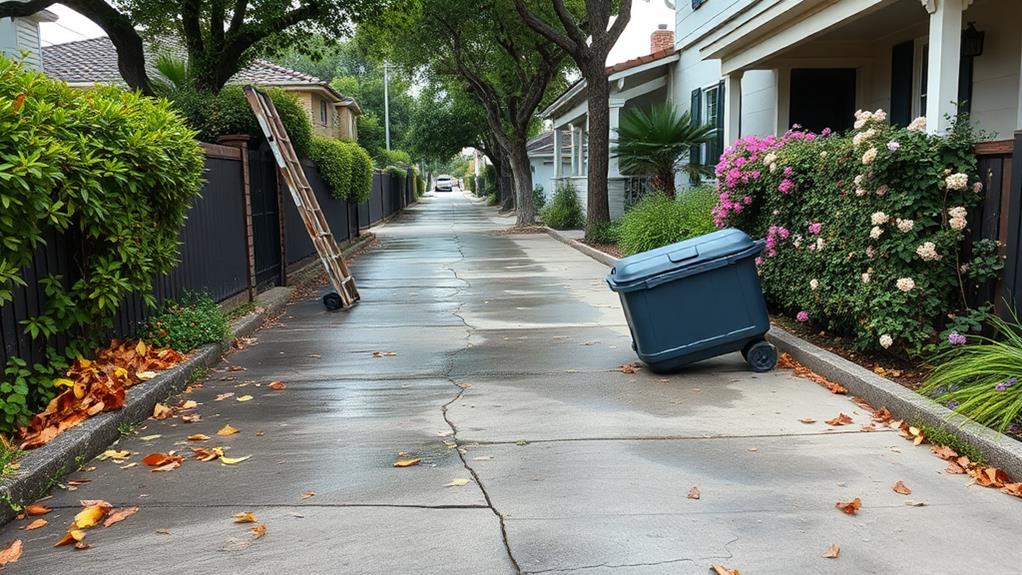
Slip and fall incidents in residential properties are all too common, often occurring due to uneven walkways, cracked driveways, or poorly maintained stairs. These dangerous conditions greatly increase the risk of slip-and-fall accidents, especially when property owners neglect their duty to maintain safe premises.
You might encounter various hazards in a residential setting that could lead to injuries. Here are some typical causes of residential property incidents:
- Wet Floors: Spills or cleaning activities can leave floors slippery, posing a fall risk if not promptly addressed.
- Loose Rugs: Rugs that aren’t secured can trip visitors, making them a common culprit in slip-and-fall accidents.
- Cluttered Pathways: Items blocking pathways can obstruct safe movement, increasing the likelihood of falls.
- Inadequate Lighting: Dim lighting in stairwells or entryways can obscure potential hazards, contributing to falls.
Property owners have a legal responsibility to address these issues. Failing to manage them can result in liability for any injuries guests sustain.
According to the CDC, falls are the leading cause of injury in residential settings, highlighting the importance of maintaining safe premises. By actively reducing these risks, you can help prevent accidents and promote safety for everyone.
Weather-Related Accidents
Beyond residential property incidents, weather-related accidents also pose a vital risk, particularly in Los Angeles where rain can turn sidewalks and parking lots into slippery hazards.
You mightn’t think it rains much in LA, but when it does, the wet conditions create perfect circumstances for slip and fall incidents. The National Safety Council highlights how these wet surfaces greatly contribute to accidents, especially during the rainy seasons.
You must stay alert, as accumulated leaves or debris can hide these hazards, making it more likely for you to slip and fall.
As a property owner in Los Angeles, it’s your responsibility to address these weather-related dangers. You’re legally obligated to manage risks like icy walkways and standing water to prevent injuries on your property.
If you slip and fall due to a property owner’s negligence, you may seek compensation. In California, proving negligence involves showing the owner didn’t maintain safe conditions during adverse weather.
This compensation can help cover medical expenses and other damages resulting from the accident. Understanding your rights and responsibilities during rainy seasons is essential to ensuring both safety and accountability in weather-related slip and fall situations.
Construction Site Risks
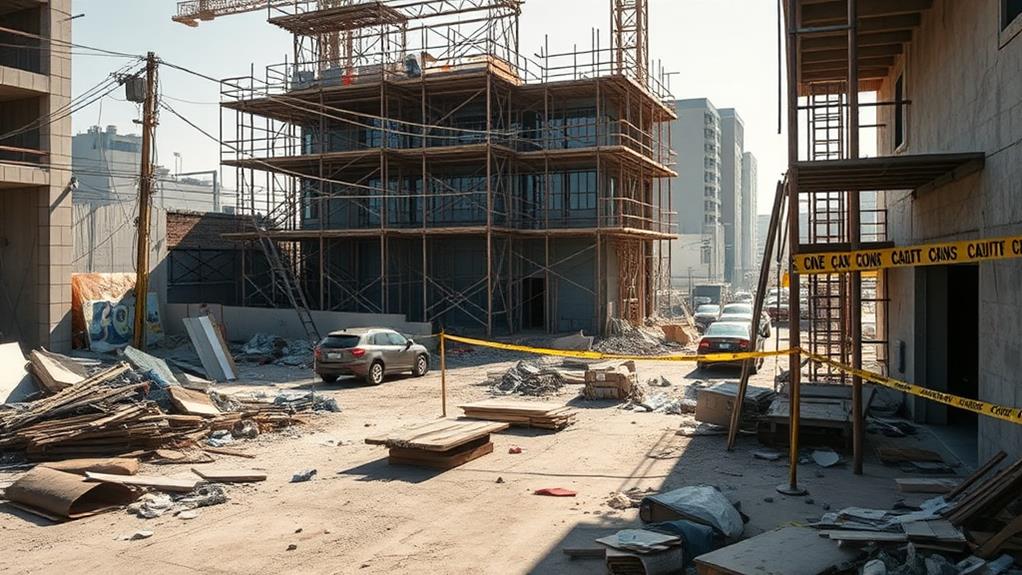
Construction sites in Los Angeles are fraught with risks that can lead to slip and fall accidents, and it’s vital to be aware of these dangers. Uneven surfaces, debris, and exposed materials are common on construction sites, greatly increasing the risk of slip and fall injuries for both workers and visitors.
Wet conditions, whether from rain or cleaning, can create slippery walkways, making slip and fall cases more likely if proper precautions aren’t taken.
Here’s what you should watch out for:
- Uneven Surfaces and Debris: These are prevalent hazards, requiring attention to avoid trips and falls.
- Inadequate Lighting: Poor lighting can obscure potential hazards, making it challenging to navigate safely, especially during early morning or evening hours.
- Lack of Proper Signage: Without clear warnings, open trenches or newly poured concrete can become serious slip and fall risks.
- Safety Gear Non-compliance: Workers should wear non-slip footwear, but when this isn’t enforced, the likelihood of slip and fall injuries increases.
Understanding these risks can help prevent personal injury.
If one occurs, knowing your rights regarding possible compensation is imperative. Always be vigilant and prioritize safety on construction sites to minimize these dangers.
Legal Considerations in LA
Maneuvering the legal landscape of slip and fall cases in Los Angeles requires a clear understanding of your rights and obligations. Property owners in LA have a duty to maintain safe premises. When negligence results in an injury, they may be held liable, opening the path for you to seek compensation.
If you’ve suffered a slip and fall accident, the clock is ticking—the statute of limitations for filing a lawsuit in California is two years from the date of the incident. Acting promptly guarantees you don’t lose your right to pursue justice.
In Los Angeles, understanding how comparative negligence affects your case is essential. If you’re found partially at fault for your injury, your compensation might be reduced. This makes it important to carefully evaluate the circumstances surrounding your slip and fall.
You can claim economic damages like medical expenses and lost wages, as well as non-economic ones such as pain and suffering, but proving negligence is key.
Legal representation is critical in maneuvering these complexities. Experienced attorneys can help assess your case, negotiate with insurance companies, and aim for fair settlements. This guarantees you’re equipped to handle the legal challenges in pursuing your rightful compensation.
Seeking Legal Help
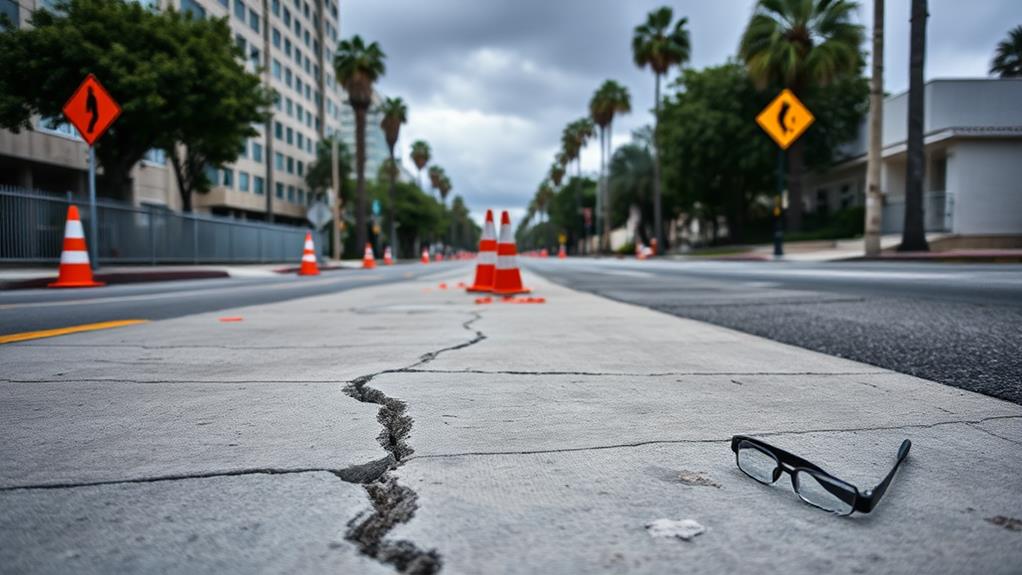
After understanding the legal framework of slip and fall cases in Los Angeles, the next step involves securing legal help. It’s essential to engage a Slip and Fall Lawyer who can navigate complex premises liability laws. Personal injury lawyers are adept at establishing liability and ensuring you receive maximum compensation.
Here’s a straightforward approach:
- Seek Medical Attention: Prioritize your health and document injuries. This evidence is important in negotiations with insurance companies.
- Consult a Lawyer Promptly: Contact a Los Angeles slip attorney soon after the incident. Many firms, like Peerali Law, offer free consultations, allowing you to discuss your case without financial commitment.
- Document Everything: Gather evidence from the scene, including photos and witness statements. Your attorney will use this to build a strong case.
- File a Lawsuit Timely: California law mandates filing a slip and fall lawsuit within two years from the accident date. Act swiftly to protect your rights.
Legal representation increases your chances of success. Skilled attorneys understand California regulations and can effectively negotiate with insurance companies.
They also know local courts and jury perceptions, which can greatly influence your case’s outcome.
Conclusion
In Los Angeles, slip and fall scenarios span several settings, from grocery aisles to construction sites. Whether it’s slippery surfaces, poor lighting, or uneven pavements, each incident highlights the significance of safety and awareness. Weather-related woes and workplace worries add to the common causes of these accidents. Understanding your rights and responsibilities is essential, and seeking legal help can guide you through the process. Remember, preparation and prudence prevent potential pitfalls in personal safety.
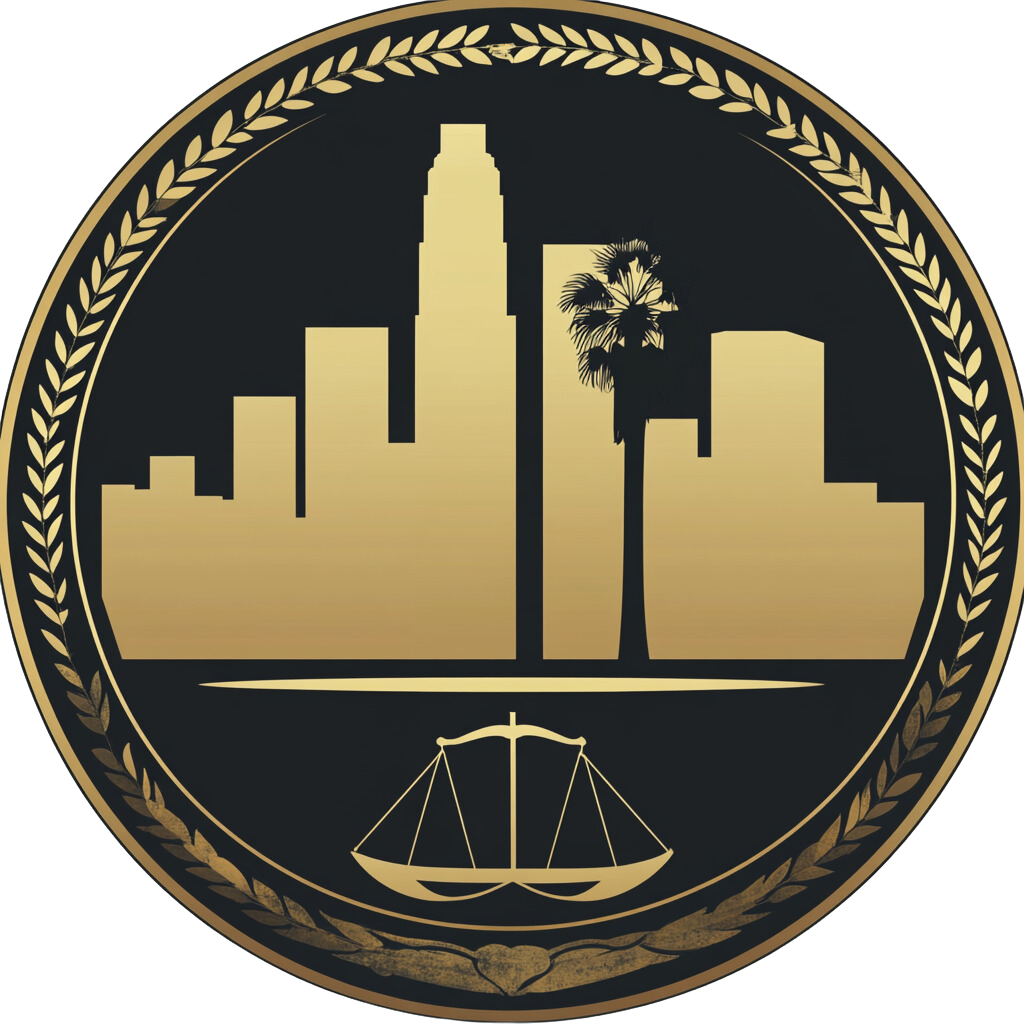
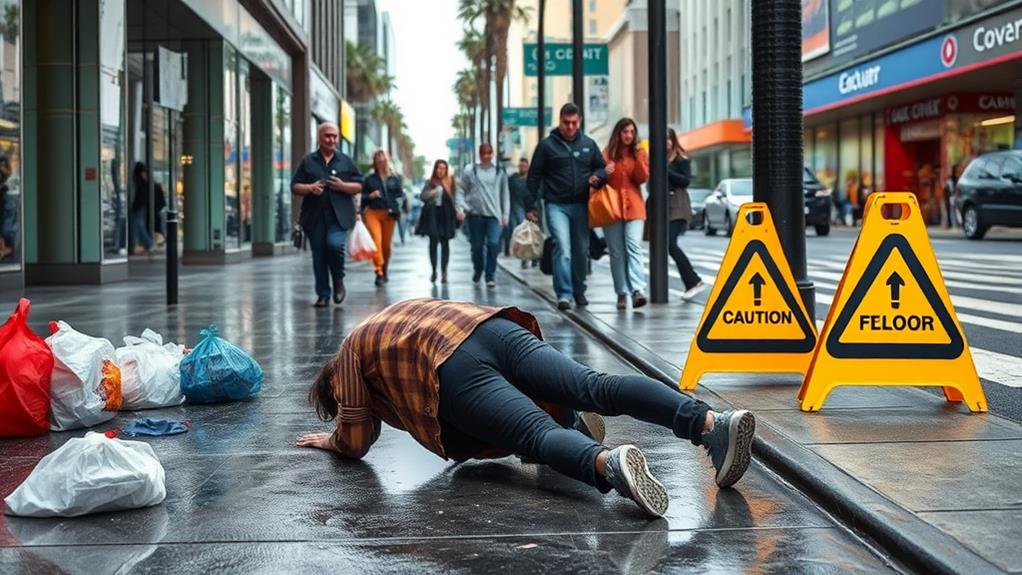
Leave a Reply